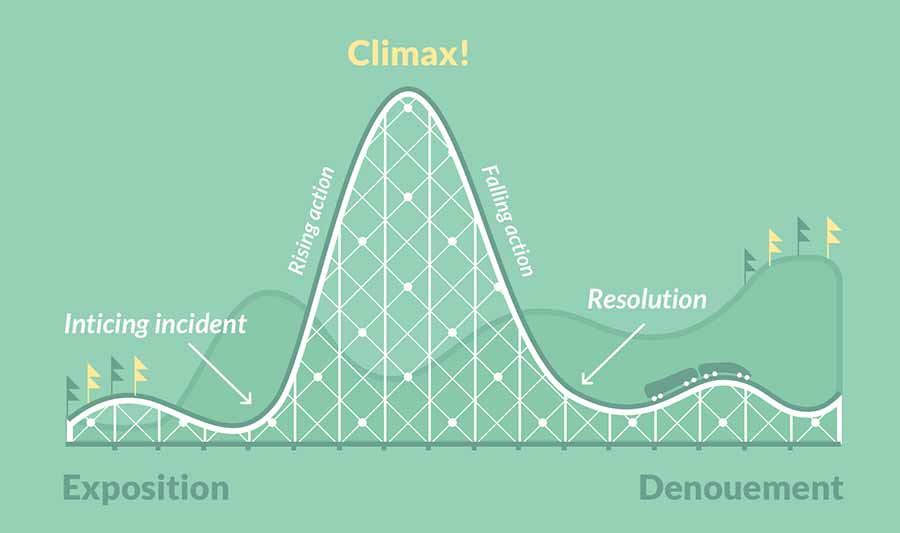Three principles of storytelling marketing
Unlock the power of storytelling in marketing with three key principles: Theme, Story Arc, and Stakes. Learn to emotionally connect and convert customers.

How can you use a story to draw attention to yourself and sell your products? Attention and sales are achieved by enticing and convincing people that they need your services or products.
You will find that people are not easily moved to make a purchase by giving facts, figures, lists or data about the wonderful features of a product. If you want to connect with your customers, you will have to touch them emotionally.
Remarkably, psychologists have only relatively recently started to study the persuasive power of stories, but the verdict was unequivocal: Stories are the most effective way to bring about change. So if you have a business, and you want to sell your products or services, you actually already want to be a storyteller, and you are also definitely curious about the following three principles of a good story.
1. Find your theme
A theme is easy to confuse with a topic. I can imagine that just the thought of the word theme takes you back to High School lessons, and you want to run away quickly. But stay with me, I will explain the concept of theme in an easy and insightful way. If you understand the idea behind theme and apply it in the story to your audience, then you will reach them more easily.
There is a difference between what happens in a story and what a story is about. A theme is what the story is about, what the deeper meaning of a story is.
Take, as an example, a florist selling a flower subscription. The customer is looking for flowers, but the theme might be beauty in the home, convenience or making a good impression for visitors.
When communicating with your customers, it is important to find out what their story is actually about and focus on that. To do that well, you need to explore the deeper grounds. The customer's real challenges and problems.
Often we get bogged down in the topic or plot of the client's story. You need flowers, buy my beautiful flowers.
But if you start from the theme of the story, the deeper grounds and motivations, then your customers will become edgy and listen. How your flowers transform the customer's home into an oasis of beauty, colours and scents.

2. Create a story arc
When I create a story, there is a set pattern. First, I describe who I was at the beginning and how I became at the end. The experiences have changed something, a transformation has taken place. This change or transformation is an essential part of any story.
You can find the possible change for your client by asking a few questions.
The first question is simple. Ask yourself what your customer has at the beginning, before they engage with you, and after.
If you sell flowers, customers will start with a house where something is missing, where there is little atmosphere. But after they have started working with you, beauty emerges in the house.
The next question goes a little deeper. How does the client feel before they engage with you? And how will they feel after they have done business with you?
Before the change, there is a slight gloom and frustration because the house seems dull and bare in comparison. But after buying, the mood changes and the customer enjoys the sight and respect of others.
If you take the client along the drama curve in a narrative way and paint them what change looks like, then you will experience trust with the client. Trust in themselves and in you as a guide.
Take your clients into your story, the whole arc, and let them experience the possibilities of change. You will see that it gives confidence in their own abilities and to be guided through a process with you as their guide.
So who is your customer before they do business with you, and who will they be after? What changes will you, your product or service bring to their lives?

3. Bring stakes into play
Crucially, let your audience know what's at stake. By this I mean what can be won but certainly also lost.
In our example, without flowers, life feels colourless and a bit empty. The family that lives there and the people who visit will miss the cheerfulness.
The stakes determine the story, the tension, the drama. Without some stakes, there is really no story.
In your communication with your potential customers, it is important to envision future success. Let them experience that this is what one will get by committing to your product or service.
Help them imagine how proud and happy they will be to have a house with flowers without having to make the effort to go out all the time.
Equally important in your story is alerting your potential customers to the negative consequences of inaction. This does not have to be done with a raised finger, but clearly paint a picture of what will happen and how it feels if nothing is done. A dull house, faded or dull flowers, lack of cosiness.
So make the stakes clear and palpable, that's how you keep the audience involved in your story. Because they know what there is to gain and lose.
Check out also my review on StoryBrand by Donald Miller.



